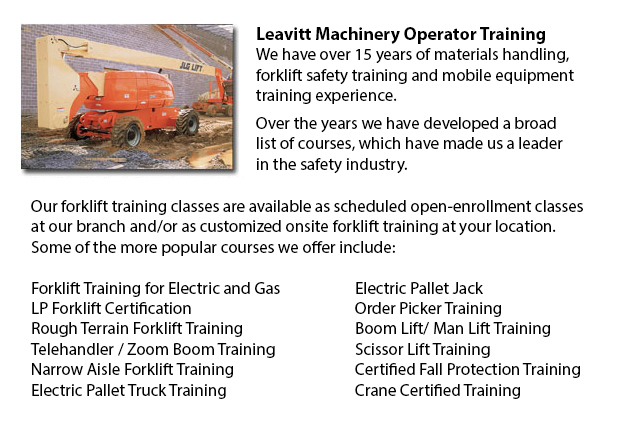
Barrie Aerial Lift Safety Training - There are roughly 26 to 30 construction fatalities in North America due to the use of aerial lifts. Nearly all of those killed are craftsmen like electrical workers, laborers, painters, carpenters or ironworkers. Nearly all deaths are caused by electrocutions, falls and tip-overs. The greatest risk is from boom-supported lifts, like cherry pickers and bucket trucks. The majority of the deaths are related to this type of lift, with the rest involving scissor lifts. Other hazards comprise being thrown out of a bucket, being struck by falling objects, and being caught between the lift bucket or guardrail and an object, such as a steel beam or joist.
To be able to operate an aerial lift safely, perform an inspection on the following items before making use of the device: operating and emergency controls, safety devices (such as, outriggers and guardrails), personal fall protection gear, and wheels and tires. Look for possible leaks in the air, hydraulic fluid and fuel-system. Check the device for loose or missing parts.
The area where the device will be utilized should be carefully inspected for possible dangers, such as bumps, holes, debris and drop-offs. Overhead power lines should be avoided or closely monitored. It is suggested that aerial lift devices be utilized on stable, level surfaces. Don't work on steep slopes that go beyond slope limitations specified by the manufacturer. Even on a level slope, wheel chocks, outriggers and brakes must be set.
Businesses should provide their aerial lift operators with the right instruction manuals. Operators and mechanics should be trained by a licensed individual experienced with the relevant aerial lift model.
Aerial Lift Safety Tips:
o Close lift platform chains or doors prior to operating.
o Leaning over and climbing on guardrails is prohibited. Stand on the floor of the bucket or platform.
o Stay within manufacturer's load-capacity limits.
o When working near traffic, make use of proper work-zone warnings, like cones and signs.
If correct procedures are followed, electrocutions are avoidable. Stay at least ten feet away from any power lines and licensed electricians should de-energize and/or insulate power lines. Those working must make use of personal protective tools and equipment, such as insulated bucket. Nevertheless, an insulated bucket does not protect from electrocution if, for instance, the worker touches another wire providing a path to the ground.
Falls are preventable if the individual working remains secure in guardrails or in the bucket by using a positioning device or a full-body harness. If there is an anchorage in the bucket, a positioning belt with a short lanyard is adequate.
By following the manufacturer's instructions, tip-overs can be prevented. Never drive the lift platform when it is elevated, unless otherwise specified by the manufacturer. Adhere to the horizontal and vertical reach limitations of the device, and never go beyond the specified load-capacity.
-
Barrie Warehouse Forklift Safety Training
Barrie Warehouse Forklift Safety Training - Businesses normally face liability for injuries and damage sustained in workplace accidents. Warehouses can be hazardous places to the individuals who work there. That is the reason why employee safety is a... More -
Barrie Aerial Platform Training
Barrie Aerial Platform Training - Aerial lifts can accommodate many duties involving high and tricky reaching places. Normally used to carry out regular upkeep in buildings with high ceilings, prune tree branches, hoist heavy shelving units or mend p... More -
Barrie Forklift Ticket
Barrie Forklift Ticket - Pallet jacks and lift trucks are both intended for practically the same reason; to transfer goods from one location of your warehouse to another. This is basically where the comparison stops however. With the pallet jack, the... More -
Barrie Aerial Lift Training
Barrie Aerial Lift Training - An aerial work platform is a mechanized access platform. This machinery provides access to otherwise not accessible places for people or equipment. Also referred to as an aerial device or elevating work platform, the mac... More -
Barrie Aerial Boom Lift Training
Barrie Aerial Boom Lift Training - For people who operate or supervise the use of aerial lift platforms, correct aerial boom lift Training is required. The aerial lift platform is utilized for lifting individuals, tools and materials to elevated work... More -
Barrie Manlift Certification
Barrie Manlift Certification - The Elevated Platforms and Manlifts Certification program helps to provide the needed training on the work practices, safe operating procedures, rules and regulations regarding the everyday activities for the operators... More -
Barrie Overhead Crane Certification
Barrie Overhead Crane Certification - The overhead crane training certification course is designed to be effective with all participants regardless of literacy or language limitations. The course has two parts: a classroom training session and a prac... More -
Wheel and Track Loader Training in Barrie
Lift trucks are obtainable in several various units that have varying load capacities. The majority of typical lift trucks utilized in warehouse settings have load capacities of one to five tons. Bigger scale models are used for heavier loads, such a... More

Forklift Certification Barrie
TOLL FREE: 1-888-254-6157
Barrie, Ontario
forkliftcertificationbarrie.com
Email Us
About Us


